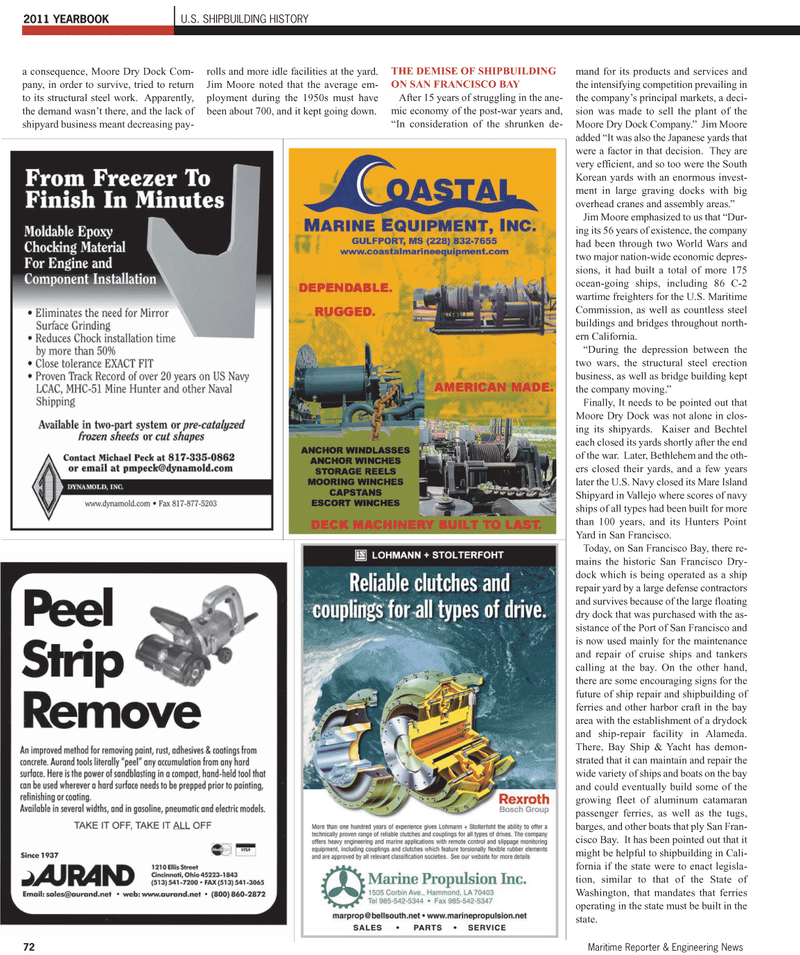
Page 76: of Maritime Reporter Magazine (June 2011)
Feature: Annual World Yearbook
Read this page in Pdf, Flash or Html5 edition of June 2011 Maritime Reporter Magazine
a consequence, Moore Dry Dock Com-pany, in order to survive, tried to return to its structural steel work. Apparently, the demand wasnt there, and the lack of shipyard business meant decreasing pay- rolls and more idle facilities at the yard. Jim Moore noted that the average em- ployment during the 1950s must have been about 700, and it kept going down. THE DEMISE OF SHIPBUILDING ON SAN FRANCISCO BAY After 15 years of struggling in the ane-mic economy of the post-war years and, In consideration of the shrunken de- mand for its products and services andthe intensifying competition prevailing in the companys principal markets, a deci- sion was made to sell the plant of the Moore Dry Dock Company.? Jim Moore added It was also the Japanese yards that were a factor in that decision. They are very efficient, and so too were the South Korean yards with an enormous invest- ment in large graving docks with big overhead cranes and assembly areas.? Jim Moore emphasized to us that Dur- ing its 56 years of existence, the company had been through two World Wars and two major nation-wide economic depres- sions, it had built a total of more 175 ocean-going ships, including 86 C-2wartime freighters for the U.S. Maritime Commission, as well as countless steelbuildings and bridges throughout north- ern California. During the depression between thetwo wars, the structural steel erection business, as well as bridge building kept the company moving.? Finally, It needs to be pointed out that Moore Dry Dock was not alone in clos- ing its shipyards. Kaiser and Bechtel each closed its yards shortly after the endof the war. Later, Bethlehem and the oth- ers closed their yards, and a few years later the U.S. Navy closed its Mare Island Shipyard in Vallejo where scores of navy ships of all types had been built for more than 100 years, and its Hunters PointYard in San Francisco. Today, on San Francisco Bay, there re- mains the historic San Francisco Dry-dock which is being operated as a shiprepair yard by a large defense contractors and survives because of the large floating dry dock that was purchased with the as- sistance of the Port of San Francisco andis now used mainly for the maintenance and repair of cruise ships and tankers calling at the bay. On the other hand, there are some encouraging signs for thefuture of ship repair and shipbuilding of ferries and other harbor craft in the bayarea with the establishment of a drydockand ship-repair facility in Alameda. There, Bay Ship & Yacht has demon- strated that it can maintain and repair thewide variety of ships and boats on the bay and could eventually build some of the growing fleet of aluminum catamaran passenger ferries, as well as the tugs,barges, and other boats that ply San Fran- cisco Bay. It has been pointed out that it might be helpful to shipbuilding in Cali- fornia if the state were to enact legisla- tion, similar to that of the State ofWashington, that mandates that ferries operating in the state must be built in the state. 72Maritime Reporter & Engineering News 2011 YEARBOOKU.S. SHIPBUILDING HISTORY

 75
75

 77
77
